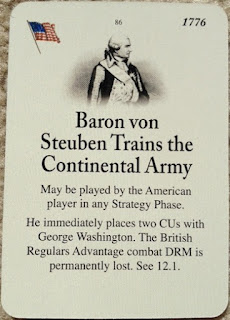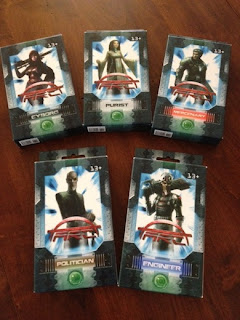One game that I was incredibly excited to receive a copy of was Washington's War.
Washington's War is a Revolutionary War board game. One player takes on the role of the British army, and the other takes on the role of the Americans. The game is played over a series of rounds - each round representing a year between 1775-1783 (in a long game). On each turn, both players get to draw 7 cards. These cards can be either "Ops" cards, or Events. Events simply do something to alter the game, or a phase of the game. They can help in combat, determine when the game ends, move the French closer to a treaty with the Americans, have Benedict Arnold betray the Americans, and many other things. There are two types of events - Mandatory and Optional. With Ops cards, a player can bring in reinforcements, move a General (possibly to attack), or gain Political Control in different regions of the board. At the end of each round, many troops are lost to winter, and Political Control can shift if certain parts of the board are isolated from others. After a certain number of turns (based on which events are played), players check for victory conditions - and whoever has Political Control over enough of the colonies is declared the winner!
The first thing that I like about Washington's War is that a lot of the elements of the game give it a nice historical theme. Specifically, some of the things like winter attrition, though incredibly challenging in gameplay terms, make complete sense in the setting of the game. One of these elements is the fact that, even in battles, you generally don't kill especially many troops. I think that this really depicts the inaccuracy of the muskets used during this time - it's much more likely that you will destroy a large army by catching them in a place where they can't flee (thus getting them to surrender) than it is to wipe out them out on the battlefield. Honestly, this element of a war game where you are pushing armies around instead of killing them reminds me of the Game of Thrones Board Game and, though I didn't really like it especially much in that game, I think that it works well in Washington's War. (It helps that you can wipe out an entire army if you can force them to surrender.)
 |
| Ok, I thought the flash made this picture look cool. |
Now that I've mentioned several things that Washington's War did very well, there were a few areas that I disliked. First, this game is overly complex. One of the reasons that I was so excited about this game is that it has a 90 minute playing time - and, for the most part, I've found this to be accurate. However, it also has a 24 page rulebook that is very text heavy (there are a lot of diagrams and such - I'm more focusing on the length than the quality), and also has another 14 page book for examples of play, strategy tips, and design notes. To read through and really understand the rulebook will probably take around an hour. I read it three times before my first game. And then, I referenced it repeatedly every time that I played. Basically, here's how it reads, "the British player performs this rule like X, but the American player does Y. Exception: in Z situation, everything is different." There really feels like an exception to every rule. Oh, and the French armies (obviously) work differently than either the American or the British armies. Yes, I realize that much of this is attempting to capture the historical feel of the Revolutionary War, but it seemed quite excessive. Additionally, I thought that, though the rules covered everything, they weren't one of GMT's better rulebooks. Rules weren't laid out in the actual order that you would encounter them in the game, and I often wanted to look up rules, but wasn't able to find what I needed in the index. This led to flipping pages and trying to remember what section covered that exception. The complexity and the rules will definitely be your biggest hurdle in enjoying Washington's War.
My next con was that I really disliked Mandatory Events. More specifically, I really disliked that Mandatory Events made your hand significantly worse. Some Mandatory Events are fairly neutral - they set what year the game will end. However, other Mandatory Events would actually help the other team! I've played card based political games (like Twilight Struggle) where you might draw your opponent's cards and you have to make the most of a bad situation. However, in Twilight Struggle, there are ways of mitigating the impact of these cards. In Washington's War, if a British player draws one of the strong American Mandatory Events, then he is forced to play it, and he doesn't get to redraw a card. So, not only does it help his opponent, it also hurts his hand because he has one card that is functionally useless. If you draw an opponent's Optional Event, then you can at least use it to give yourself an advantage in combat, or discard it to perform a political action. With the Mandatory Events, it's like having a card in your hand that says "Pass."
 |
| Playing this card helps. A lot. |
Overall, I give Washington's War a 7.0/10. If you can get through the rules and start playing the game, then there is quite a bit to like about the game. However, with the very steep entrance barrier mixed with the fairly high luck factor for the game, it didn't quite live up to the expectations that I had for it.
If Washington's War sounds interesting to you, then you might also want to check out 1989: Dawn of Freedom, Game of Thrones, and Twilight Struggle (really, everyone should check out Twilight Struggle if you haven't yet).
I would like to thank GMT Games for providing me with a review copy of Washington's War.




















